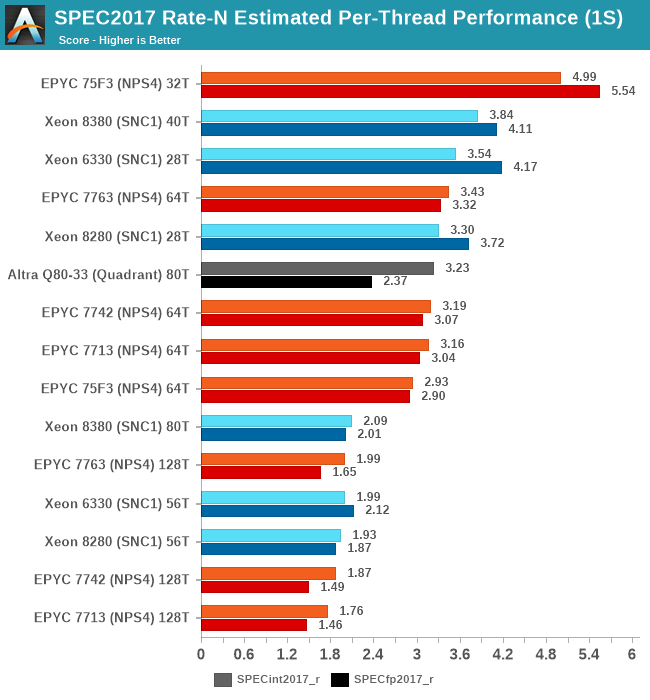Intel 3rd Gen Xeon Scalable (Ice Lake SP) Review: Generationally Big, Competitively Small
by Andrei Frumusanu on April 6, 2021 11:00 AM EST- Posted in
- Servers
- CPUs
- Intel
- Xeon
- Enterprise
- Xeon Scalable
- Ice Lake-SP
SPEC - Per-Core Performance under Load
A metric that is actually more interesting than isolated single-thread performance, is actually per-thread performance in a fully loaded system. This actually is a measurement and benchmark figure that would greatly interest enterprises and customers which are running software or workloads that are possibly licensed on a per-core basis, or simply workloads that require a certain level of per-thread service level agreement in terms of performance.
This has been a strong-point of Intel SKUs for some time now, even when the chips wouldn’t be competitive in terms of total throughput. With the new Ice Lake SPs SKUs now more notably increasing total throughput, it’ll be interesting to see the per-thread breakdown and resulting performance:

Because the total throughput generational performance increase is larger than the core count increase of the parts, this means that per-thread and per-core performance is higher with this generation. The Xeon 8380 is posting +16.3% and +10.4% per-thread performance versus the Xeon 8280 when only using one thread per core.
Interestingly, these figures are less at +8.2 and +7.4% when using both SMT threads per core. Intel has explained such an increase through the better usage of shared microarchitectural structure usage in the new Sunny Cove cores, essentially diminishing the SMT yield by improving 1/T per core performance.
Generally, Intel is extremely competitive in this benchmark metric, and while AMD easily beats them with the frequency-optimised parts, it’s an advantage that should help Intel in the SLA-centric workloads.










169 Comments
View All Comments
Hifihedgehog - Tuesday, April 6, 2021 - link
Correction: Maybe if it was released over two years ago...amootpoint - Wednesday, April 7, 2021 - link
Not really. Just look at the perf numbers vs AMD. Intel is broadly winning.Bagheera - Thursday, April 8, 2021 - link
which review article did you read? didn't sound like you read the same one I did.Unashamed_unoriginal_username_x86 - Tuesday, April 6, 2021 - link
the 8280 core to core bounce latency image is 404ingRyan Smith - Tuesday, April 6, 2021 - link
This has been fixed. Thanks!JayNor - Tuesday, April 6, 2021 - link
News release says "The platform supports up to 6 terabytes of system memory per socket".This story says 4TB. Is Intel wrong?
ParalLOL - Tuesday, April 6, 2021 - link
Depends on whether you agree to say that Optane is "system memory". It is mapped onto address space and is directly attached to CPU so it probably can be said to be system memory.DigitalFreak - Tuesday, April 6, 2021 - link
It's like when Intel says their desktop processors have 40 PCIe lanes. It's actually 16 CPU and 32 chipset. Well 20 CPU with Rocket Lake, but still...brucethemoose - Tuesday, April 6, 2021 - link
Y'all are measuring power from the socket sensors, not the wall, right?I think the later would be more interesting, even with the apples-to-oranges factor of different hardware surrounding the platform. After all, whole system power consumption is what one gets charged for.
Jorgp2 - Tuesday, April 6, 2021 - link
That would vary massively between systems.